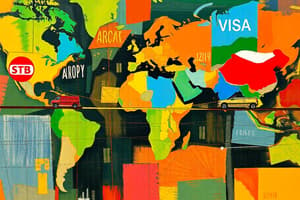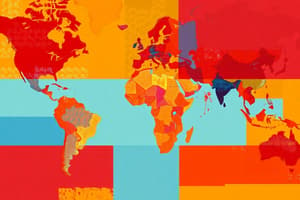Podcast
Questions and Answers
What characterizes an import-oriented distribution structure?
What characterizes an import-oriented distribution structure?
- Offers direct access from producers to end users.
- It facilitates global distribution networks.
- Supplies are abundant and prices are low.
- A limited supply of goods is sold at high prices. (correct)
In which distribution structure does demand exceed supply?
In which distribution structure does demand exceed supply?
- National distribution system
- Import-oriented distribution structure (correct)
- Retail-centric distribution structure
- Japanese distribution structure
What is a typical feature of the Japanese distribution structure?
What is a typical feature of the Japanese distribution structure?
- Direct transactions without middlemen.
- Dominated by large retailers and distributors.
- Many small middlemen dealing with many small retailers. (correct)
- Control of the channel by a small number of importers.
What role do middlemen play in the distribution process?
What role do middlemen play in the distribution process?
Which statement is true regarding the import-oriented distribution structure?
Which statement is true regarding the import-oriented distribution structure?
What is a significant feature of the business philosophy in Japan regarding retailer relationships?
What is a significant feature of the business philosophy in Japan regarding retailer relationships?
What is the impact of the Large-Scale Retail Store Law (Daitenho) in Japan?
What is the impact of the Large-Scale Retail Store Law (Daitenho) in Japan?
How do consumer goods typically reach the consumer in Japan?
How do consumer goods typically reach the consumer in Japan?
Which of the following statements reflects a characteristic of Japanese consumer goods pricing?
Which of the following statements reflects a characteristic of Japanese consumer goods pricing?
What is one method employed by companies like Coca-Cola for inventory financing in Japan?
What is one method employed by companies like Coca-Cola for inventory financing in Japan?
What is the primary role of agent middlemen?
What is the primary role of agent middlemen?
Which of the following describes logistics management?
Which of the following describes logistics management?
Which option is NOT a part of channel management?
Which option is NOT a part of channel management?
What does the Large-Scale Retail Store Location Act pertain to?
What does the Large-Scale Retail Store Location Act pertain to?
Which of the following is a benefit of the European Union’s unification?
Which of the following is a benefit of the European Union’s unification?
What is a characteristic of merchant middlemen?
What is a characteristic of merchant middlemen?
What is the aim of examining logistics costs systematically?
What is the aim of examining logistics costs systematically?
In the context of distribution, what does 'breaking-bulk' refer to?
In the context of distribution, what does 'breaking-bulk' refer to?
Flashcards
Distribution Process
Distribution Process
The process through which goods move from producers to end consumers, involving handling, ownership transfers, and negotiations between producers, middlemen, and customers.
Distribution Structure
Distribution Structure
A specific arrangement of producers, wholesalers, retailers, and other intermediaries involved in distributing products within a particular country.
Import-Oriented Distribution Structure
Import-Oriented Distribution Structure
A distribution structure where importers control limited goods, selling them at high prices to a small affluent customer base. Demand exceeds supply, and distribution is largely local.
Japanese Distribution Structure
Japanese Distribution Structure
Signup and view all the flashcards
Large-Scale Retail Store Law (Daitenho)
Large-Scale Retail Store Law (Daitenho)
Signup and view all the flashcards
High Density of Middlemen
High Density of Middlemen
Signup and view all the flashcards
Japanese Business Philosophy
Japanese Business Philosophy
Signup and view all the flashcards
Channel Control
Channel Control
Signup and view all the flashcards
High Cost of Consumer Goods
High Cost of Consumer Goods
Signup and view all the flashcards
Agent Middleman
Agent Middleman
Signup and view all the flashcards
Merchant Middleman
Merchant Middleman
Signup and view all the flashcards
Channel Management
Channel Management
Signup and view all the flashcards
Logistics Management
Logistics Management
Signup and view all the flashcards
Physical Distribution
Physical Distribution
Signup and view all the flashcards
Total Physical Distribution Costs
Total Physical Distribution Costs
Signup and view all the flashcards
Elimination of Transportation Barriers
Elimination of Transportation Barriers
Signup and view all the flashcards
Logistics Cost Analysis
Logistics Cost Analysis
Signup and view all the flashcards
Study Notes
International Distribution and Retailing
- International distribution involves the entire process of moving goods from producer to consumer across international borders.
- This process includes physical handling, ownership transfer, and negotiations between producers, middlemen, and consumers.
- Each country possesses a unique distribution structure, affecting how goods reach consumers.
- Distribution structures vary based on countries.
- Different distribution systems exist, like the import-oriented structure.
Import-Oriented Distribution Structure
- This traditional structure is characterized by a single importer controlling a fixed quantity of goods.
- Marketing strategies focus on selling limited stocks to high-value customers at high prices.
- There is a significant demand-supply imbalance, where customer demand often exceeds limited supply.
- Distribution systems tend to be local rather than national.
- Fewer countries today operate within this model.
Japanese Distribution Structure
- This system has numerous small middlemen that work with numerous small retailers.
- Manufacturers exert significant control over the distribution network, often attributed to vertical integration.
- Unique cultural values influence business philosophies.
- Laws limit the proliferation of large-scale retail stores, thereby supporting small retailers.
High Density of Middlemen
- In Japan, goods often pass through several intermediaries before reaching customers, unlike Western markets which favor large-scale retailers.
- Independent groceries and bakers represent a considerable segment of Japanese retail (94.7%).
- Supermarkets, discount stores, and department stores dominate Western markets.
Channel Control
- Inventory financing, often seen in six-month payment cycles for companies like Coca-Cola in Japan, influences channel control.
- Cumulative rebates incentivize retailer loyalty, and cooperation.
- Other channel control tactics encompass merchandise returns and promotional support.
Business Philosophy
- Japanese distribution systems emphasize long-term dealer-supplier relationships, rooted in loyalty, harmony and friendship.
- This approach results in lower prices to the small retailer, a considerable advantage compared to broader development of large retailers.
- Due to the emphasis on loyalty, Japanese consumer goods are often priced high worldwide.
Large-Scale Retail Store Law and its Successor
- The Daitenho law regulates the opening of retail stores exceeding 500 square meters, limiting their operating hours, and changing their operating day standards.
- The Ministry of International Trade and Industry (MITI) initially approves proposals related to larger retail.
- Foreign and domestic companies were bound by the law.
- The Large-Scale Retail Store Location Act of 2000 succeeded it.
Alternative Middleman Choices
- Sellers must exert influence over middlemen in both the home country and the foreign country.
- Agent middlemen represent principals, while merchant middlemen take title to the goods and operate independently.
Channel Management
- Essential aspects of channel management include locating, selecting, motivating, terminating, and controlling middlemen.
Logistics
- Logistics management involves a comprehensive approach to managing the entire distribution process.
- Physical movement of raw materials, work in progress (WIP inventory), and finished goods encompass the distribution process from production to end user consumption.
- This includes warehousing, transportation, inventory management, distribution plant location, and breaking bulk for lower volume delivery.
Logistics, Continued
- Systematic planning of logistics and calculation of distribution costs can offer significant savings.
- The goal is to achieve optimal system costs, balancing costs with customer satisfaction and efficiency, particularly important when considering the logistics aspects of distribution.
- The European Union has eliminated many trade barriers due to its unification, facilitating the smooth delivery of goods among member countries.
Studying That Suits You
Use AI to generate personalized quizzes and flashcards to suit your learning preferences.




